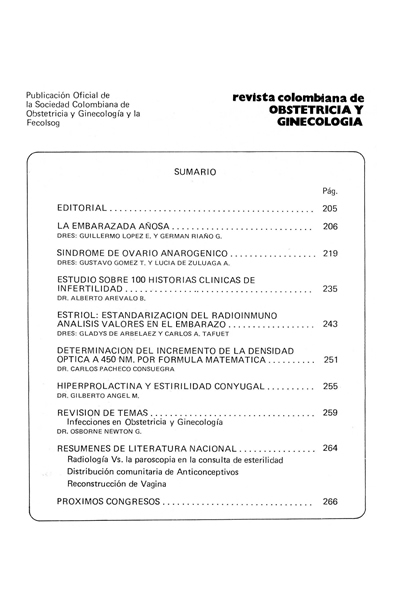Hiperprolactinemia y esterilidad conyugal
DOI:
https://doi.org/10.18597/rcog.1251Resumen
La prolactina es producida por el lóbulo anterior de la hipófisis y regulada por el sistema nervioso central e hipotálamo. La hiperprolactinemia bloquea la acción gonadotrófica de las hormonas folículo estimulante (FSH) y luteinizante (LIH) provocando un retardo en la actividad cíclica del ovario, manifestada clínicamente por ciclos irregulares o permanecer asintomática, pero produciéndose invariablemente insuficiencia luteínica, que es evidente histológicamente en los endometrios pre-menstrual o menstrual, con ausencia o deficiencia en la reacción pseudo decidual, indispensable para la implantación del embrión, y de arterias espirales que desempeñan un importante papel en la placentación posterior.
La depuración y a la vez popularización de las técnicas de radio-inmunoensayo en Laboratorio Clínico, han permitido verificar más investigaciones hormonales, derivándose de su conjunto valiosos aportes prácticos, pues las dificultades anteriores en las dosificaciones hormonales hacían que muchos conceptos permanecieran en el terreno de lo académico sin traspasar al terreno de la práctica. La prolactina permaneció durante tiempo prolongado, como indicadora de procesos inmorales en la silla turca y de su actividad lactoqénica. En el año de 1971 se reconoció en la prolactina sus acciones bloqueadoras en las hormonas gonadotróficas y es prácticamente desde dicho tiempo que toman auge sus determinaciones y múltiples aplicaciones.
Sus niveles elevados se asocian con hipogonadismo tanto masculino como femenino, desarrollando sintomatologías larvadas, evidentes, o simplemente consecuentes como sucede en la mujer infértil asintomática, donde la prolactina está ejerciendo su función fisiológica anticonceptiva, sin producir lactancia.
Biografía del autor/a
Gilberto Angel M., Clínica Los Remedios
Médico Patólogo Clínico Jefe Laboratorio Médico Clínica Los Remedios - Cali
Referencias bibliográficas
No. 217: Pág. 97: A study of galactorrhoea, etiology and management. Kanjilal and Cols. College-Hospital Calcutta-lndia.
No. 218: Pág. 98: Failure of pyrodoxine B6) o inhibit serotonin stimulated prolactine release in non lactating women. Foukas and Cols. Medical Schhol-Athenas-GRECE.
No. 219: Pag. 98: Plasma prolactin responses to thyrotrophin releasing hormone in momen with idiopathic hyperprolactinemia. Evans and Cols. Hospital London-UNITED KINGDOM.
No. 220: Pág. 99: Clinical course and outcome of pregnancy in 25 patients with pituitary microadenomas.
Jawlewicz and Col. College of Phys. Surg. NEW YORK.
No. 230: Pág. 103: Reversal of the day-night rhytm of serum prolactin in policystic ovarian.
Gorrafa —Aly School of Medicine— Day-ton (Ohio) U.S.A.
No. 231: Pág. 104: Estrogen dependence of prolactin secretion in the policystic ovary síndrome. Results of bromocriptine treatment.
Del Pozo y Colab. University of Rome-ITA-LIA.
No. 236: Pág. 106: Effect of lisurid (Ergot derívate) in the treatment of hyperprolactinemia and galactorrhoea.
Tempone A y Colab. Cátedra Ginecología —BUENOS AIRES—
No. 237: Pag. 106: The effect of lisuride in the hyperprolactinemia, amenorrhoea sydrome and puerperal lactation.
De Ceceo L-Clinica Ostetricia —Genove— ITALIA.
No. 238: Pag. 107: The efect of lisuride in hiperprolactinemia states.
Floersheim and Cols. Dept. Gynec. Endo. Zirich-SWITZERLAND.
No. 239: Pág. 107: The treatment with 2 brom alfa ergocriptin (Parlodel) in the syndrome amenorrhoea galactorreaoe.
Sirbu and Cols. Depto. Obst. and Gynec. Bucharest-RUMANIA.
No. 254: Pág. 112: Prolactin levels in postmenopausal women.
Castellanos y Colab. Clin. San Jordi-Barcelona-ESPAÑA.
No. 279: Pág. 126: Therapeutic effect of bromocryptine in anovulatory women with normal prolactin levels.
Waronski W. Acad. Inst. Obst. and Gynec. Katowicwe-POLAND.
No. 293: Pág. 133: Ergocryptine treatment in high prolactin sterility.
Borenstein and Col. Univ. Med. School. Rehovot-ISRAEL.
No. 299: Pág. 136: The course and outcome of pregnancy after ovulation induction with short term bromocryptine therapy. Klimek R. Inst. Obst. and Gynec. Gracow-POLAND.
No. 301: Pág. 137: Determination of keto-prostaglandin, LH, FSH and prolactin in seminal fluid of fertile and infertile men. Klinge K. Runnebaunm. B. Univ. Fraune-klinik-HEIDELBER.
No. 177: Pág. 79: Modulation of the regulatory mechanisme of prolactin secretion. S. Scapagnini U. and Colbs. Univ. of Catania-ITALIA.
No. 179: Pág. 80: Evaluation of pituitary function tests in hyperprolactinemic amenorrhoea.
Shaw R-Glass MDept. Obst. and Ginec Birmingham-UNITED KINGOM.
No. 182: Pág. 81: Sex diference in the hormonal regulation of human prolactin receptor in rast livers.
Furuhashi N —Tohoku Univ. Myyagi— JAPAN.
No. 183: Pág. 82: Biosynthesis and rekease of prolactin.
Hoshino K-Kyoto Univ. Kyoto-Tokio-JAPAN.
Crosignani P. G. and Robyn C.
Prolactin and human reproduction —Crosignani and Robyn— Academic. Press. New York, 1977.
Human pituitary prolactin-Shome B and Parlow A.
J. Clin. Endocrin: 45: 1112. 1977.
Galactorrehoea-Treatment with normocryp-tine-Besser G. M.
J. Med. 1669. 1972.
Hyperprolactinemic anovulatory syndrome Bohnet H. G.
J. Clin. Endocrin. Metab. 42: 132, 1976.
Studies of mechanism of the dopamine mediate inhibition of prolactin secretion. Macleod R. and Lehmeyer.
J. Endocrin. 94: 1077, 1974.
Effect of ergot drugs on central cathecho-lamine neurona. Corrodi H. Fuke — J. Pharm. Pharmacol. 25: 409. 1973.
Incidence and significance of hyperprolactinemia in women with amenorrhoea Kranks S-Murray M.
Clin Endocrin. 4: 597. 1975.
Prolactin and gonadotrhophin interaction. Thomer M O. —Edwards C— Press New York. 1976.
Bromocriptine therapy of female infertility. Thorner M. O. Brit. Med. J. 4: 694. 1975.
An abnormality of prestrogen feed back in amenorrhoea. Glass M. R. —Shaw R. W—. Med. J. End. 3: 274, 1976.
Sterility and considerations. Bohnet M. G. J. Clin Endocrin. 42: 132. 1976.
What. Why and Weere prolactin? E. Del Pozo Sandorama 11/1979. Sandoz Ltda.
Tratamiento del hipogonadismo con bromo-criptina. —Thorner M. O. and Besser—. Simposio del Colegio Real de Médicos. Pág. 54-62. Londres. 1976.
Evaluación clínica por el Laboratorio. Gilberto Angel M. —Edit. Tercer Mundo— Bogotá, marzo 1979.
Patología y fisiología del endometrio-Sammartino R. Simposium para Graduados-Mendoza (Argentina). Julio 6. 13. 1959.
ESTIRILIDAD-Tyler T. E.
Edit. Méd. Panamericana. Buenos Aires. 1973.
Esterilidad conyugal. Ahumada J. C. y Colaboradores —Edit. Panamericana— Buenos Aires. 1964 (Cap. endometrio).
Cómo citar
Descargas
Descargas
Publicado
Número
Sección
| Estadísticas de artículo | |
|---|---|
| Vistas de resúmenes | |
| Vistas de PDF | |
| Descargas de PDF | |
| Vistas de HTML | |
| Otras vistas | |
















